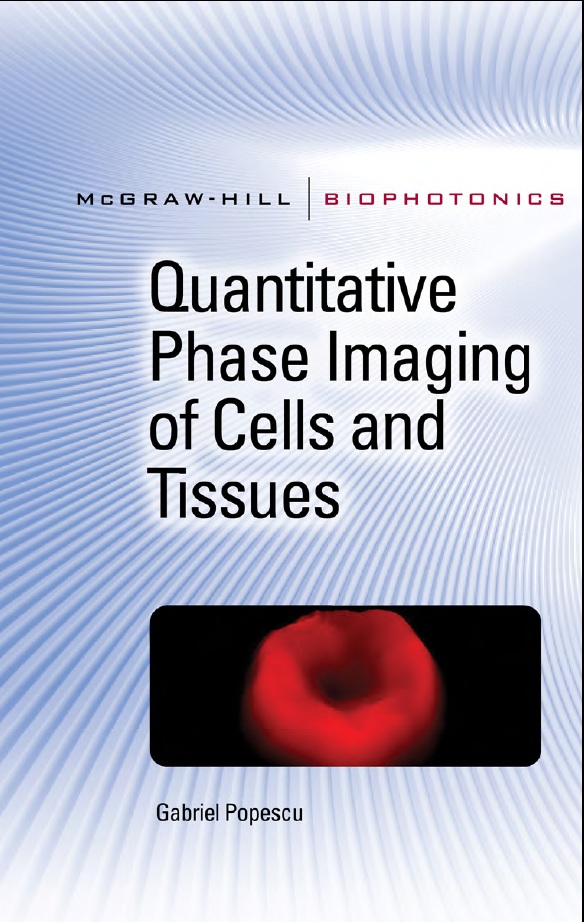by Gabriel Popescu
Contents

Popescu G. (2011) Quantitative phase imaging of cells and tissues (McGraw-Hill, New York) p 385.
Cover
About the Author
Dedication
Motto
Foreword by Emil Wolf
Preface
Acknowledgments
Chapter 1. Introduction
1.1. Light microscopy
1.2. Quantitative phase imaging (QPI)
1.3. Multimodal investigation based on QPI
1.4. Nanoscale and three-dimensional imaging
Chapter 2.Groundwork
2.1. Light propagation in free space
2.1.1. 1D propagation: plane waves
2.1.2. 3D propagation: spherical waves
2.2. Fresnel approximation of wave propagation
2.3. Fourier transform properties of free space
2.4. Fourier transform properties of lenses
2.5. Born approximation of light scattering in inhomogeneous media
2.6. Scattering by single particles.
2.7. Particles under the Born approximation
2.7.1. Spherical particles
2.7.2. Cubical particles
2.7.3. Cylindrical particles
2.8. Ensembles of particles within the Born approximation.
2.9. Mie scattering
Chapter3. Spatiotemporal field correlations
3.1. Spatiotemporal correlation function. Coherence volume.
3.2. Spatial correlations of monochromatic light
3.2.1. Cross-spectral density
3.2.2. Spatial power spectrum
3.2.3. Spatial filtering
3.3. Temporal correlations of plane waves
3.3.1. Temporal autocorrelation function
3.3.2. Optical power spectrum
3.3.3. Spectral filtering
Chapter 4. Image characteristics
4.1. Imaging as linear operation
4.2. Resolution
4.3. Signal to noise ratio (SNR)
4.4. Contrast and contrast to noise ratio (CNR)
4.5. Image filtering
Chapter 5. Light microscopy
5.1. Abbe’s theory of imaging
5.2. Imaging of phase objects
5.3. Zernike’s phase contrast microscopy
Chapter6. Holography
6.1. Gabor (in-line) holography
6.2. Leith and Upatnieks (off-axis) holography
6.3. Nonlinear (real time) holography
6.4. Digital holography
6.4.1. Digital hologram writing
6.4.2. Digital hologram reading
Chapter 7. Point scanning QPI methods
7.1. Low-coherence interferometry (LCI)
7.2. Dispersion effects
7.3. Time-domain optical coherence tomography (OCT)
7.3.1. Depth-resolution in OCT
7.3.2. Contrast in OCT
7.4. Fourier-domain and swept source OCT
7.5. Qualitative phase-sensitive methods
7.5.1. Differential phase contrast OCT
7.5.2. Interferometric phase dispersion microscopy
7.6.Quantitative methods
7.6.1. Phase-referenced interferometry
7.6.2. Spectral domain QPI
7.7. Further developments
Chapter 8. Principles of full-field QPI
8.1. Interferometric imaging
8.2. Temporal phase modulation: phase shifting interferometry
8.3. Spatial phase modulation: off-axis interferometry
8.4. Phase unwrapping
8.5. Figures of merit in QPI
8.5.1. Temporal sampling: acquisition rate
8.5.2. Spatial sampling: transverse resolution
8.5.3. Temporal stability: temporal phase sensitivity
8.5.4. Spatial uniformity: spatial phase sensitivity
8.6. Summary of QPI approaches and figures of merit
Chapter 9. Off-axis methods
9.1. Digital holographic microscopy (DHM)
9.1.1. Principle
9.1.2. Further developments
9.1.3. Biological applications
9.1.3.1. Cell imaging
9.1.3.2. Cell growth
9.2. Hilbert phase microscopy (HPM)
9.2.1. Principle
9.2.2. Further developments
9.2.2.1. Actively stabilized HPM (s-HPM)
9.2.2.2. HPM and confocal reflectance microscopy
9.2.3. Biological applications
9.2.3.1. Red blood cell morphology
9.2.3.2. Cell refractometry in microfluidic channels
9.2.3.3. Red blood cell membrane fluctuations
9.2.3.4. Tissue refractometry
Chapter 10. Phase-shifting methods
10.1. Digitally recorded interference microscopy with automatic phase shifting (DRIMAPS)
10.1.1. Principle
10.1.2. Further developments
10.1.3. Biological applications
10.2. Optical quadrature microscopy (OQM)
10.2.1. Principle
10.2.2. Further developments
10.2.3. Biological applications
Chapter 11. Common-path methods
11.1. Fourier phase microscopy (FPM)
11.1.1. Principle
11.1.2. Further developments
11.1.3. Biological applications
11.1.3.1. Slow fluctuations in red blood cell membranes
11.1.3.2. Cell growth
11.1.3.3. Cell motility
11.2. Diffraction phase microscopy (DPM)
11.2.1. Principle
11.2.2. Further developments
11.2.2.1. Diffraction phase and fluorescence microscopy (DPF)
11.2.2.2. Confocal diffraction phase microscopy
11.2.3. Biological applications
11.2.3.1. Fresnel particle tracking using DPM
11.2.3.2. Red blood cell mechanics
11.2.3.3. Imaging malaria-infected RBCs
Chapter 12. White light methods
12.1. QPI using the transport of intensity equation
12.1.1. Principle
12.1.2. Further developments
12.1.3. Biological applications
12.2. Spatial light interference microscopy (SLIM)
12.2.1. Principle
12.2.2. Further developments
12.2.2.1. SLIM-fluorescence multimodal capability
12.2.2.2. Computational imaging
12.2.3. Biological applications
12.2.3.1. Cell dynamics
12.2.3.2. Cell growth
Chapter 13. Fourier transform light scattering (FTLS)
13.1. Principle
13.1.1. Relevance of light scattering methods
13.1.2. FTLS
13.2. Further developments
13.3. Biological applications
13.3.1. Elastic light scattering of tissues
13.3.2. Elastic light scattering of cells
13.3.3. Dynamic light scattering of cell membranes
13.3.4. Dynamic light scattering of cell cytoskeleton
Chapter 14.Current trends in methods
14.1. Tomography via QPI
14.1.1. Computed tomography via digital holographic microscopy (DHM)
14.1.2. Diffraction tomography via spatial light interference microscopy (SLIM)
14.2. Spectroscopic QPI
14.2.1. Spectroscopic diffraction phase microscopy
14.2.2. Instantaneous spatial light interference microscopy (iSLIM)
Chapter 15. Current trends in applications
15.1. Cell dynamics
15.1.1. Background and motivation
15.1.2. Active membrane fluctuations
15.1.3. Intracellular mass transport
15.1.3.1. Introduction
15.1.3.2. Principle
15.1.3.3. Measurements on Brownian systems
15.1.3.4. Measurements on live cells
15.2. Cell growth
15.2.1. Background and motivation
15.2.2. Cell cycle-resolved cell growth
15.3. Tissue optics
15.3.1. Background and motivation
15.3.2. Scattering- phase theorem
15.3.2.1. Proof of the ls-f relationship
15.3.2.2. Proof of the g-f relationship
15.3.3. Tissue scattering properties from organelle to organ scale
15.4. Clinical applications
15.4.1. Background and motivation
15.4.2. Blood screening
15.4.3. Label-free tissue diagnosis
APPENDIX
A. Complex analytic signals
B. The two-dimensional and three-dimensional Fourier transform
C. QPI artwork